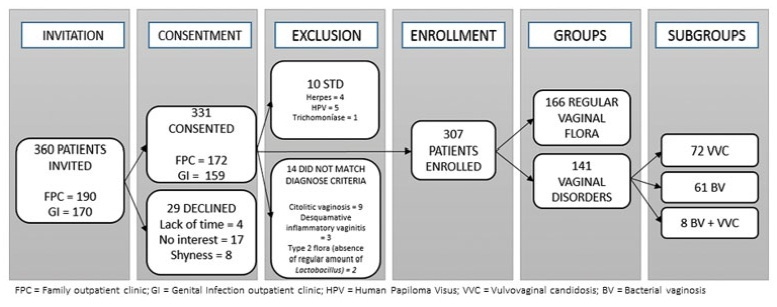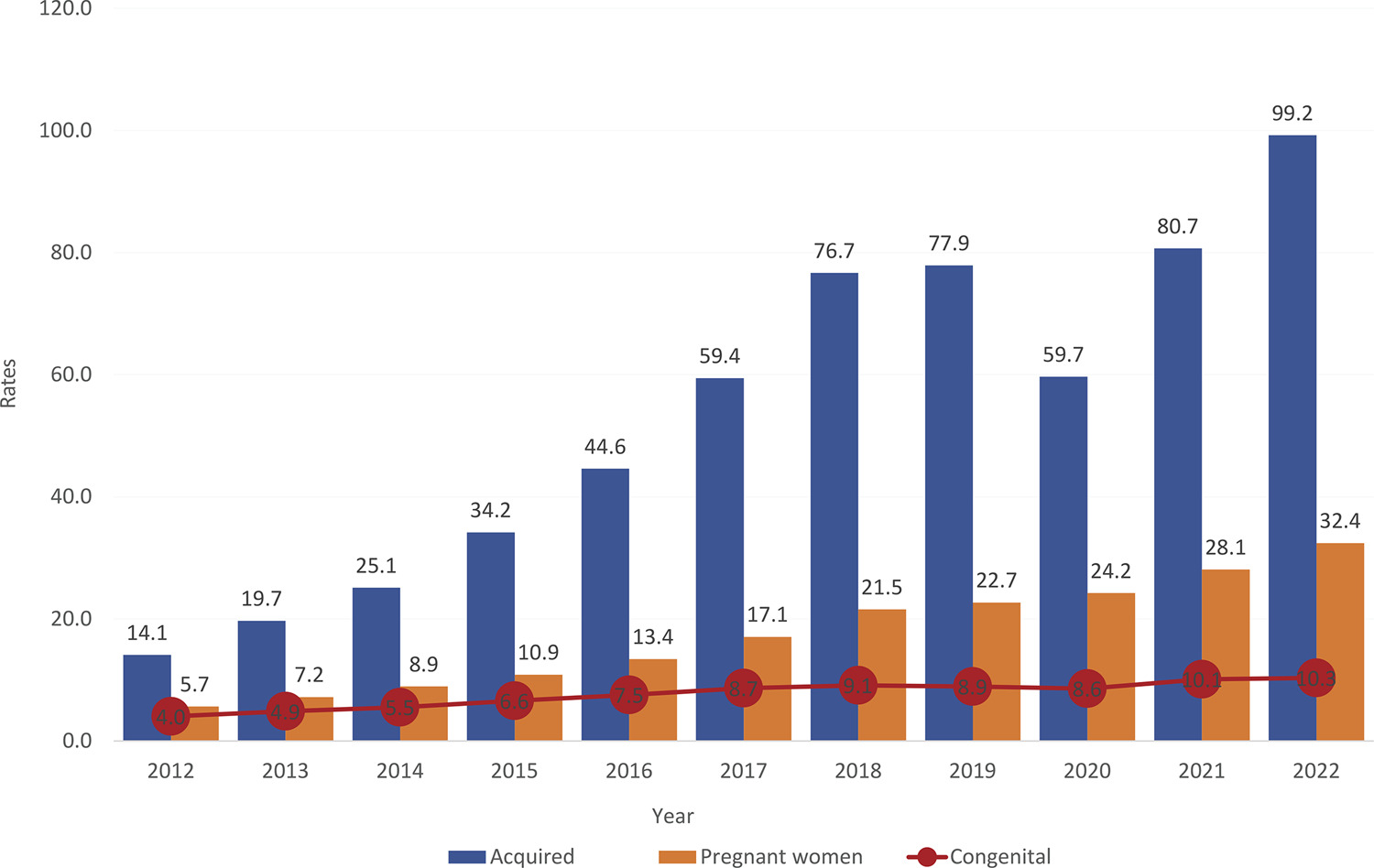-
Trabalhos Originais
Correlation between the Histological Report of Biopsy and Conization by the Loop Electrosurgical Excision Procedure (LEEP) in the Treatment of Cervical Intraepithelial Neoplasia
Revista Brasileira de Ginecologia e Obstetrícia. 2000;22(2):65-70
10-10-2000
Summary
Trabalhos OriginaisCorrelation between the Histological Report of Biopsy and Conization by the Loop Electrosurgical Excision Procedure (LEEP) in the Treatment of Cervical Intraepithelial Neoplasia
Revista Brasileira de Ginecologia e Obstetrícia. 2000;22(2):65-70
10-10-2000DOI 10.1590/S0100-72032000000200002
Views114Purpose: to evaluate conization by the loop electrosurgical excision procedure (LEEP) for the diagnosis and treatment of cervical intraepithelial neoplasms (CIN), the importance of the margins and follow-up of these women. Methods: 95 women who underwent conization by LEEP for CIN and microinvasive carcinoma from January 1996 to December 1997 were evaluated. For statistical analysis, we used the kappa agreement coefficient and the tendency test of Cochran Armitage. Results: among 63 cases who underwent colposcopically directed biopsy before the conization, the cone presented the same grade of lesion in 20 and no residual disease in 8. The cone lesion presented a higher grade in 24 cases and one of them was a microinvasive carcinoma. Among the 25 women who underwent the cone biopsy with a previous biopsy suggestive of cervicitis or CIN 1, 56% had CIN 2 or 3 in the cone. Among the 32 women without previous biopsy, 15 had CIN 2 or 3, and four had microinvasive carcinoma in the cone. Regarding the margins of the cone, 25 cases presented some grade of CIN in the endocervical margins and 2/10 who underwent a second procedure presented residual disease on histological analysis. Among the 70 women with free cone margins, 2/4 who underwent a second procedure had residual disease on histological analysis. Conclusion: conization by LEEP without previous directed biopsy depends on the experience of the colposcopist. The second resection after LEEP for the diagnosis and treatment of CIN depends not only on the presence of disease in the cone margins but also on the follow-up. A second histological analysis is recommended in cases with microinvasive carcinoma and glandular lesion and affected margins.
Key-words Cancer screeningCervical intraepithelial neoplasiaCervical neoplasiaColposcopyLoop electro-surgical cone biopsySee more -
Editorial
FEBRASGO e o Ministério da Saúde: A Parceria Lógica
Revista Brasileira de Ginecologia e Obstetrícia. 2000;22(2):64-64
10-10-2000
Summary
EditorialFEBRASGO e o Ministério da Saúde: A Parceria Lógica
Revista Brasileira de Ginecologia e Obstetrícia. 2000;22(2):64-64
10-10-2000 -
Resumos de Teses
Efeito do Tamoxifeno na Expressão do Antígeno Nuclear de Proliferação Celular (PCNA) no Epitélio e no Estroma do Fibroadenoma de Mulheres no Menacme
Revista Brasileira de Ginecologia e Obstetrícia. 2000;22(7):461-461
10-06-2000
Summary
Resumos de TesesEfeito do Tamoxifeno na Expressão do Antígeno Nuclear de Proliferação Celular (PCNA) no Epitélio e no Estroma do Fibroadenoma de Mulheres no Menacme
Revista Brasileira de Ginecologia e Obstetrícia. 2000;22(7):461-461
10-06-2000DOI 10.1590/S0100-72032000000700014
Views51Efeito do Tamoxifeno na Expressão do Antígeno Nuclear de Proliferação Celular (PCNA) no Epitélio e no Estroma do Fibroadenoma de Mulheres no Menacme[…]See more -
Trabalhos Originais
Risk Factors for Infection after Total Abdominal Hysterectomy
Revista Brasileira de Ginecologia e Obstetrícia. 2000;22(7):443-448
10-06-2000
Summary
Trabalhos OriginaisRisk Factors for Infection after Total Abdominal Hysterectomy
Revista Brasileira de Ginecologia e Obstetrícia. 2000;22(7):443-448
10-06-2000DOI 10.1590/S0100-72032000000700007
Views66See morePurpose: to determine the main factors associated with the occurrence of surgical site infection in patients submitted to total abdominal hysterectomy at the Instituto Materno ¾ Infantil de Pernambuco (iMIP). Methods: a cross-sectional study was conducted, enrolling patients submitted to total abdominal hysterectomy at IMIP who returned to postsurgical consultation for infection control, between January, 1995 and December, 1998 (n = 414). The frequency of surgical site infection (defined according to the CDC criteria, 1998) was 10% (42 cases). Prevalence risk (PR) of infection (dependent variable) and its 95% confidence interval (CI) were calculated for independent variables: age, obesity, hypertension, diabetes, malignant pathology, type of incision, duration of surgery and antibiotic prophylaxis. Multiple logistic regression analysis was used to determine adjusted risk of infection. Results: a significantly increased risk of infection was found for the following variables: age >60 years (PR = 2.39, 95% CI = 1.15-4.94), obesity (PR = 3.2, 95% CI = 1.83-5.59), duration of surgery >2 hours (PR = 2.35, 95% CI = 1.32-4.21) and diabetes (PR = 6.0, 95% CI = 3.41-10.57). On the other hand, risk of infection was significantly reduced when antibiotic prophylaxis was administered (PR = 0.38, 95% CI = 0.21-0.68). Type of incision, malignant disease and hypertension were not associated with infection. Conclusions: the factors associated with increased risk of surgical site infection after total abdominal hysterectomy at IMIP were: age >60 years, obesity, diabetes and surgical duration >2 hours. Antibiotic prophylaxis showed a protective effect with reduction of risk of infection.
-
Trabalhos Originais
Evaluation of Proliferative Activity in the Mammary Epithelium Adjacent to Fibroadenoma in Women Treated with Tamoxifen
Revista Brasileira de Ginecologia e Obstetrícia. 2000;22(7):429-433
10-06-2000
Summary
Trabalhos OriginaisEvaluation of Proliferative Activity in the Mammary Epithelium Adjacent to Fibroadenoma in Women Treated with Tamoxifen
Revista Brasileira de Ginecologia e Obstetrícia. 2000;22(7):429-433
10-06-2000DOI 10.1590/S0100-72032000000700005
Views106See morePurpose: to study the monoclonal antibody MIB-1 in the normal breast epithelium adjacent to a fibroadenoma in women in the luteal phase of the menstrual cycle treated with tamoxifen. Patients and methods: the proliferative activity of the mammary epithelium adjacent to the fibroadenoma was studied by immunohistochemistry based on immunoexpression of the monoclonal antibody MIB-1. The study was randomized and double blind and was conducted on 44 women with fibroadenomas, divided into 3 groups: A (n = 16; placebo), B (n = 15; tamoxifen, 10 mg), and C (n = 13; tamoxifen, 20 mg). Tamoxifen was administered for 22 days starting on the 2nd day of the menstrual cycle and a biopsy was taken on the 23rd day. Results: the mean percentage of stained nuclei per 1000 cells was 9.2 in group A, 4.5 in group B, and 3.2 in group C. Fisher’s test revealed that tamoxifen significantly reduced the immunoexpression of MIB-1 at the doses of 10 and 20 mg compared to the placebo group (p<0.0001), with no significant differences between doses in terms of proliferative activity (p = 0.21). Conclusion: we conclude that tamoxifen significantly reduced the proliferative activity of the mammary epithelium at the doses of 10 and 20 mg/day.
PlumX Metrics
- Citations
- Citation Indexes: 1
- Usage
- Full Text Views: 6070
- Abstract Views: 717
- Captures
- Readers: 1
-
Trabalhos Originais
Natural Triplet Pregnancies: Maternal Complications and Perinatal Results
Revista Brasileira de Ginecologia e Obstetrícia. 2000;22(7):413-419
10-06-2000
Summary
Trabalhos OriginaisNatural Triplet Pregnancies: Maternal Complications and Perinatal Results
Revista Brasileira de Ginecologia e Obstetrícia. 2000;22(7):413-419
10-06-2000DOI 10.1590/S0100-72032000000700003
Views84See morePurpose: to analyze maternal complications and perinatal results of triplet pregnancies. Method: retrospective study of maternal and perinatal data on all triplets weighing >500 g delivered in a period of 8 years at Maternidade Escola de Vila Nova Cachoeirinha. Results: between 1990-1998, 18 women gave birth to triplets, representing 1 in every 2,060 deliveries. The main complications were preterm delivery (94.4%) and preeclampsia (44.4%) and 83.3% of these patients needed hospitalization before delivery, for 1-50 days, most in order to inhibit preterm labor. Cesarean section was performed in 88.9%, the mean gestational age at birth was 34.2 weeks (+ 1.8), mean weight 1,827 g (+ 421), 20.4% weighed <1,500 g and 75.9% weighed 1,500-2,499 g. Birth weight discrepancy (> 25%) occurred in 38.9% of these pregnancies and 35.2% of the 54 fetuses were small for gestational age. Eighty-six percent of live-born infants had neonatal morbidity and 3.7% had evident congenital anomalies. Perinatal mortality was 16.7%, 7.4% due to intrauterine demise and 9.3% due to neonatal death. The mean duration of hospitalization in the neonatal ward was 18.5 days; late neonatal sepsis was the main cause of death. Conclusion: triplet pregnancies had high a incidence of obstetric complications, demanded prolonged maternal hospitalization and ended almost always in surgical delivery. Intrauterine and neonatal death rates were high, neonatal morbidity was detected in almost all live-born infants and their hospitalization was long, exposing these prematures to infection, their main cause of death. Triplet pregnancies carry high maternal and fetal risks and should be managed at tertiary facilities.
-
Trabalhos Originais
The Relationship between White’s Classification and the Histopathological Changes in the Placentas of Diabetic Pregnant Women
Revista Brasileira de Ginecologia e Obstetrícia. 2000;22(7):401-411
10-06-2000
Summary
Trabalhos OriginaisThe Relationship between White’s Classification and the Histopathological Changes in the Placentas of Diabetic Pregnant Women
Revista Brasileira de Ginecologia e Obstetrícia. 2000;22(7):401-411
10-06-2000DOI 10.1590/S0100-72032000000700002
Views50See morePurpose: to analyze the relationship between White’s classification and the histopathological, changes occurring in the placentas of diabetic pregnant women, performing a qualitative comparison of histopathological changes in the placentas of nondiabetic pregnant women with those in diabetic ones (classes A and A/B), clinical, short duration (classes B and C), and clinical with vasculopathy (classes D to FRH), studying the influence of the quality of glycemic control and of gestational age on placental changes in the three groups of diabetic pregnant women. Patients and methods: specimens of placentas were collected from all diabetic pregnant women seen between 1991 and 1996 in the Maternity Section of the Hospital das Clínicas, Faculdade de Medicina de Botucatu, stained using the hematoxylin-eosin technique, and submitted to a histopathological examination. The quality of glycemic control was analyzed by the glycemia average of gestation and classified as adequate or inadequate, with a limit of 120 mg/dl. Gestational age was individualized as term and preterm. Results: forty-two newborns (43.3%) were born at term and the remaining were preterm (56.7%). The prematurity rate was higher for women with clinical diabetes (classes B and C; D to FRH). Some histopathological alterations were observed only in placentas from diabetic pregnant women: cystoid degeneration, chorial edema, intima edema, dysmaturity, Hofbauer cell hyperplasia, villitis, ghost cells, two vessels in the umbilical cord, and endarteritis. Conclusions: histopathological changes in the placentas of pregnant women with gestational diabetes (classes A and A/B), clinical, short duration (classes B and C), and clinical with vasculopathy (classes D to FRH) were similar to those in the nondiabetic ones, and, therefore, were independent of White’s clinical classification. The histopathological changes in the placentas of pregnant women with gestational diabetes (classes A and A and B), clinical, short duration (classes B and C), and clinical with vasculopathy (classes D to FRH) were not related to gestational age at birth and to the quality of glycemic control of the mother. The comparison between histopathological changes and the increased number of preterm newborns in clinical diabetes, class D to FRH, suggest early placental ageing in clinical diabetes patients.
-
Resumos de Teses
Avaliação da Quantidade do Colágeno da Pele de Ratas Castradas após o Uso de Estrogênio, Progestagênio e Tamoxifeno
Revista Brasileira de Ginecologia e Obstetrícia. 2000;22(7):462-462
10-03-2000
Summary
Resumos de TesesAvaliação da Quantidade do Colágeno da Pele de Ratas Castradas após o Uso de Estrogênio, Progestagênio e Tamoxifeno
Revista Brasileira de Ginecologia e Obstetrícia. 2000;22(7):462-462
10-03-2000DOI 10.1590/S0100-72032000000700016
Views44Avaliação da Quantidade do Colágeno da Pele de Ratas Castradas após o Uso de Estrogênio, Progestagênio e Tamoxifeno[…]See more
Search
Search in:
Tag Cloud
Pregnancy (251)Breast neoplasms (104)Pregnancy complications (103)Risk factors (103)Menopause (87)Ultrasonography (83)Cesarean section (77)Prenatal care (71)Endometriosis (70)Obesity (60)Infertility (56)Quality of life (53)prenatal diagnosis (51)Women's health (48)Maternal mortality (45)Pregnant women (45)Breast (44)Postpartum period (44)Uterine cervical neoplasms (43)Prevalence (42)





